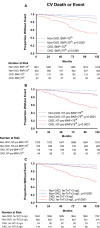Effect Modification of Chronic Kidney Disease on the Association of Circulating and Imaging Cardiac Biomarkers With Outcomes
- PMID: 28679558
- PMCID: PMC5586272
- DOI: 10.1161/JAHA.116.005235
Effect Modification of Chronic Kidney Disease on the Association of Circulating and Imaging Cardiac Biomarkers With Outcomes
Abstract
Background: Cardiac troponin T and brain natriuretic peptide (BNP) are elevated in >50% of dialysis patients and are associated with poor outcomes. Few data investigated these associations in earlier chronic kidney disease (CKD).
Methods and results: We studied whether CKD modified associations of elevated BNP, N-terminal-pro-BNP, high-sensitivity cardiac troponin T, coronary artery calcification, and left ventricular hypertrophy with all-cause death and cardiovascular death/events in 3218 multiethnic individuals followed for 12.5 years, and whether biomarkers added prognostic information to traditional cardiovascular risk factors in CKD. Of the cohort, 279 (9%) had CKD. There were 296 deaths and 218 cardiovascular deaths/events. Of non-CKD individuals, 7% died and 6% had cardiovascular death/event versus 32% and 30% of CKD participants, P<0.001 for both. The interaction between BNP and CKD on death was significant (P=0.01): the adjusted hazard ratio in CKD was 2.05, 95% CI (1.34, 3.14), but not significant in non-CKD, 1.04 (0.76, 1.41). CKD modified the association of high-sensitivity cardiac troponin T with cardiovascular death/event, adjusted hazard ratio 3.34 (1.56, 7.18) in CKD versus 1.65 (1.16, 2.35) in non-CKD, interaction P=0.09. There was an interaction between N-terminal-pro-BNP and CKD for death in those without prior cardiovascular disease. Addition of each biomarker to traditional risk factors improved risk prediction, except coronary artery calcification was not discriminatory for cardiovascular death/event in CKD.
Conclusions: Cardiac biomarkers, with the exception of coronary artery calcification, prognosticated outcomes in early-stage CKD as well as, if not better than, in non-CKD individuals, even after controlling for estimated glomerular filtration rate, and added to information obtained from traditional cardiovascular risk factors alone.
Keywords: N‐terminal‐pro‐brain natriuretic peptide; cardiac biomarkers; cardiovascular outcomes; chronic kidney disease; coronary artery calcium; mortality; troponin T.
© 2017 The Authors. Published on behalf of the American Heart Association, Inc., by Wiley.
Figures




Similar articles
-
NT-proBNP and troponin T and risk of rapid kidney function decline and incident CKD in elderly adults.Clin J Am Soc Nephrol. 2015 Feb 6;10(2):205-14. doi: 10.2215/CJN.04910514. Epub 2015 Jan 20. Clin J Am Soc Nephrol. 2015. PMID: 25605700 Free PMC article.
-
Utility of traditional circulating and imaging-based cardiac biomarkers in patients with predialysis CKD.Clin J Am Soc Nephrol. 2015 Mar 6;10(3):515-29. doi: 10.2215/CJN.03600414. Epub 2014 Nov 17. Clin J Am Soc Nephrol. 2015. PMID: 25403922 Free PMC article. Review.
-
Risk stratification in stable coronary artery disease is possible at cardiac troponin levels below conventional detection and is improved by use of N-terminal pro-B-type natriuretic peptide.Eur J Prev Cardiol. 2014 Oct;21(10):1275-84. doi: 10.1177/2047487313492099. Epub 2013 May 30. Eur J Prev Cardiol. 2014. PMID: 23723326 Clinical Trial.
-
Cardiovascular Determinants of Mortality in Advanced Chronic Kidney Disease.Am J Nephrol. 2020;51(9):726-735. doi: 10.1159/000509582. Epub 2020 Aug 10. Am J Nephrol. 2020. PMID: 32777781
-
Prognostic Value of High-Sensitivity Troponin T in Chronic Heart Failure: An Individual Patient Data Meta-Analysis.Circulation. 2018 Jan 16;137(3):286-297. doi: 10.1161/CIRCULATIONAHA.117.031560. Circulation. 2018. PMID: 29335288
Cited by
-
Advances in the Progression and Prognosis Biomarkers of Chronic Kidney Disease.Front Pharmacol. 2021 Dec 21;12:785375. doi: 10.3389/fphar.2021.785375. eCollection 2021. Front Pharmacol. 2021. PMID: 34992536 Free PMC article. Review.
-
Association of Monocyte Chemoattractant Protein-1 with Death and Atherosclerotic Events in Chronic Kidney Disease.Am J Nephrol. 2018;47(6):395-405. doi: 10.1159/000488806. Epub 2018 Jun 6. Am J Nephrol. 2018. PMID: 29874658 Free PMC article.
-
Impaired Renal Function on Cholesterol Efflux Capacity, HDL Particle Number, and Cardiovascular Events.J Am Coll Cardiol. 2018 Aug 7;72(6):698-700. doi: 10.1016/j.jacc.2018.05.043. J Am Coll Cardiol. 2018. PMID: 30072004 Free PMC article. No abstract available.
-
Any grade of relative overhydration is associated with long-term mortality in patients with Stages 4 and 5 non-dialysis chronic kidney disease.Clin Kidney J. 2018 Jun;11(3):372-376. doi: 10.1093/ckj/sfy018. Epub 2018 Mar 28. Clin Kidney J. 2018. PMID: 29942502 Free PMC article.
-
Are Cardiac Biomarkers to Predict Cardiovascular Outcomes in Patients with Chronic Kidney Disease Ready for Prime Time?Mayo Clin Proc. 2019 Nov;94(11):2158-2160. doi: 10.1016/j.mayocp.2019.09.013. Mayo Clin Proc. 2019. PMID: 31685144 Free PMC article. No abstract available.
References
-
- United States renal data system: USRDS 2014 annual report volume 1: chronic kidney disease in the United States. 2014. Available at: https://www.usrds.org/2014/view/v1_04.aspx. Accessed 7/1/2016.
-
- Abbas NA, John RI, Webb MC, Kempson ME, Potter AN, Price CP, Vickery S, Lamb EJ. Cardiac troponins and renal function in nondialysis patients with chronic kidney disease. Clin Chem. 2005;51:2059–2066. - PubMed
-
- Vickery S, Price CP, John RI, Abbas NA, Webb MC, Kempson ME, Lamb EJ. B‐type natriuretic peptide (BNP) and amino‐terminal proBNP in patients with CKD: relationship to renal function and left ventricular hypertrophy. Am J Kidney Dis. 2005;46:610–620. - PubMed
-
- Dubin RF, Li Y, He J, Jaar BG, Kallem R, Lash JP, Makos G, Rosas SE, Soliman EZ, Townsend RR, Yang W, Go AS, Keane M, Defilippi C, Mishra R, Wolf M, Shlipak MG; Investigators CS . Predictors of high sensitivity cardiac troponin T in chronic kidney disease patients: a cross‐sectional study in the chronic renal insufficiency cohort (CRIC). BMC Nephrol. 2013;14:229. - PMC - PubMed
MeSH terms
Substances
Grants and funding
LinkOut - more resources
Full Text Sources
Other Literature Sources
Medical

